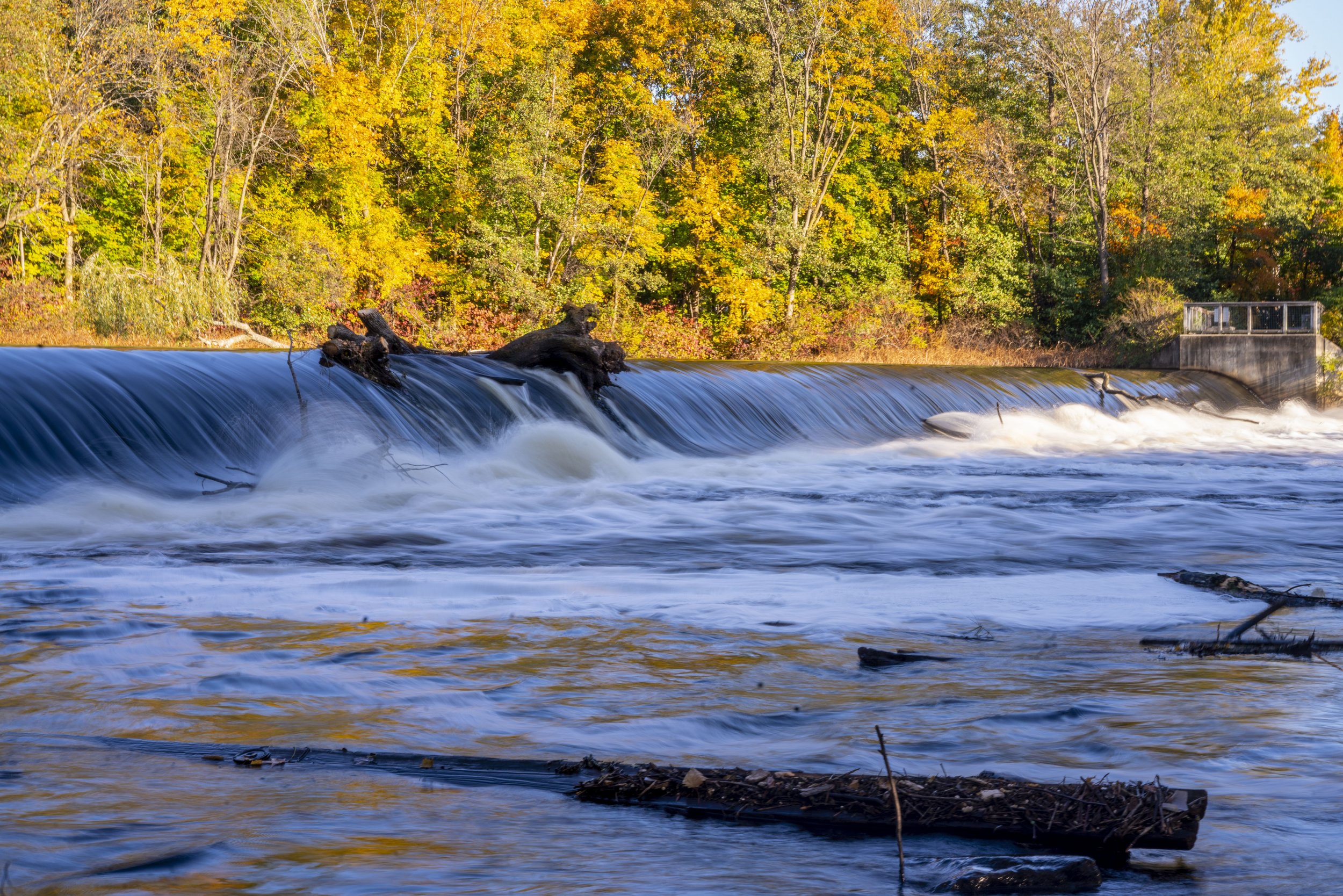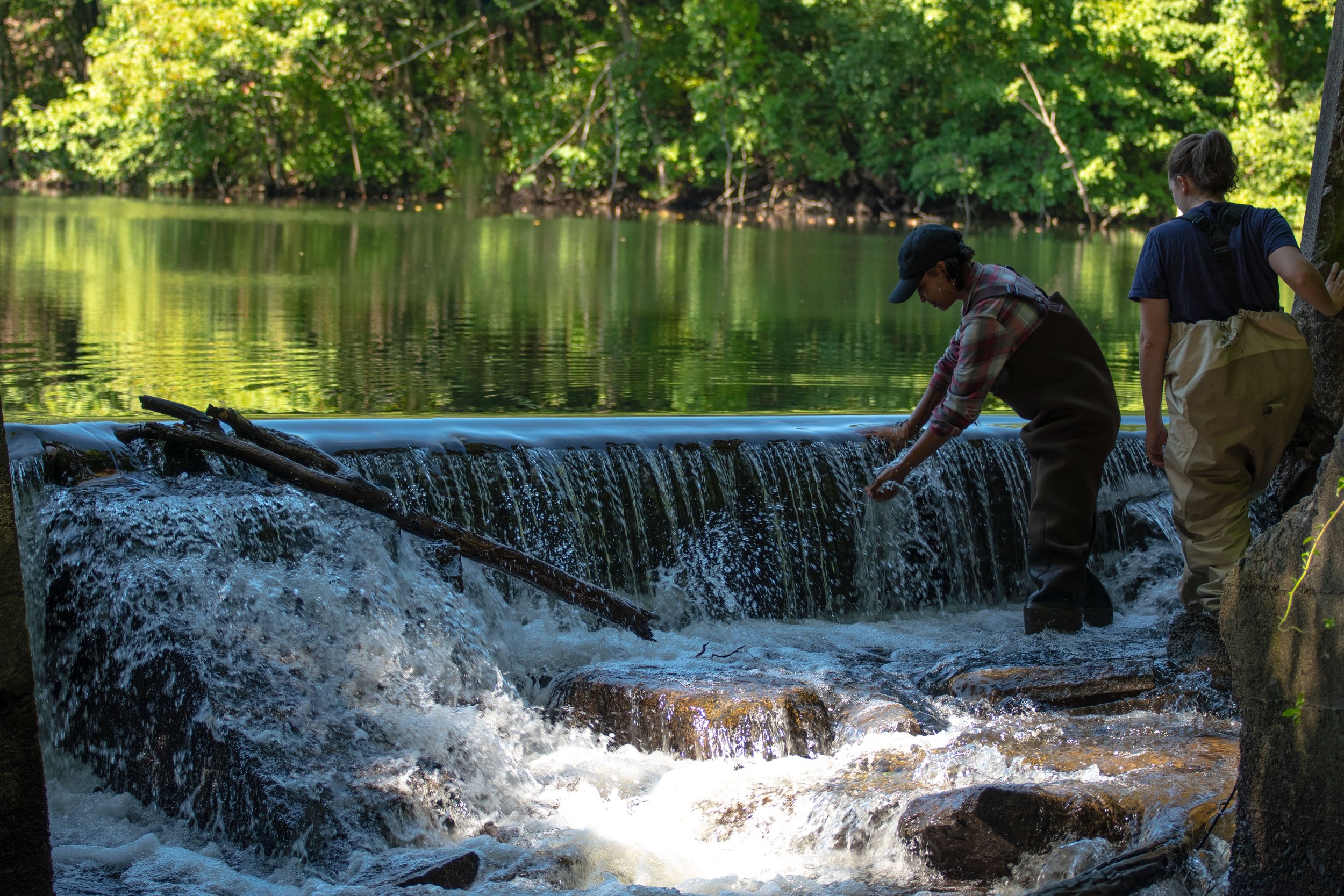
WATERTOWN DAM
A case for removal.
A detriment to the Charles River.
An aging, 180-ft long, 8-ft high aging concrete weir structure located in the Charles River in Watertown currently owned by the Department of Conservation and Recreation (DCR), Watertown Dam was originally constructed to power industry, yet now holds no purpose for power or flood control. CRWA advocates for the removal of the Watertown Dam to improve fish passage, restore biodiversity, enhance water quality, and avoid dam failure.
Current Status
The Massachusetts Department of Conservation and Recreation (DCR) has contracted an engineering consultant to perform an alternatives analysis study for potential future actions at the Watertown Dam. In addition, the DCR project team is hosting two public meetings to share the preliminary results of the ongoing study and possible future alternatives for modifications to the dam, including removal. Watch a recording of the first meeting from July 9, 2024. A second meeting was held on September 25, 2024. Review the presentation slides.
In 2016, an inspection report deemed Watertown Dam to be in a "poor" condition. As a result, the Charles River Watershed Association applied for support from the Department of Ecological Restoration to conduct a feasibility study. The purpose of this study was to investigate the removal of Watertown Dam. Dam removal is increasingly becoming a popular approach in Massachusetts as our aging dams obstruct the passage of migratory fish, deteriorate river ecosystems, and are susceptible to failure due to the effects of climate change, including more frequent extreme weather events.
The Watertown Dam Removal Feasibility Study was released by the Massachusetts Division of Ecological Restoration (DER) in June 2021. The study showed that it is possible to remove the dam and restore the river. We are now working on gathering grassroots support for the restoration of this site.
READ LETTERS OF SUPPORT:
American Rivers, Watertown City Council, Watertown Conservation Commission, Newton Conservators,Green Newton,Weston Conservation Commission, Wellesley Natural Resources Commission, Dedham Sustainability Committee, Waltham Conservation Commission, Waltham Land Trust, Natick Sustainability Committee, The Nature Conservancy, Mass Audubon, Massachusetts Rivers Alliance, Native Fish Coalition Massachusetts, Sierra Club Massachusetts, Trout Unlimited Greater Boston Chapter, Charles River Regional Chamber.
CRWA is compiling written testimonies in support of the immediate removal of DCR's Watertown Dam. We need your voice to push state and local leaders to act on removing DCR's Watertown Dam.

Frequently Asked Questions
-
There are over 3,000 dams in the state, and 100+ in the Charles River Watershed alone. While a small number are important, the majority are not in use.
Removal of defunct dams offers the opportunity to acknowledge the rights of present-day Nipmuc, Massachusett, and Wampanoag people, revive migratory fish populations, restore the river ecosystem, and build climate resilience across the watershed.
-
Some. While the dam is not in imminent danger of breach, if failure did occur safety could cause safety concerns.
DCR’s Office of Dam Safety has classified Watertown dam as a “Significant Hazard Potential”, meaning the failure of the dam “may cause loss of life and damage to home(s), industrial or commercial facilities, secondary highway(s) or railroad(s) or cause interruption of use or service of relatively important facilities.” In 2021, an inspection report found that Watertown Dam was in "Fair" condition, meaning it has “significant operational and maintenance deficiencies, but not structural deficiencies”. A controlled dam removal is the most effective means of addressing these potential safety issues.
-
No. In fact, initial modeling predicts that dam removal would result in slightly lower flood elevations.
Watertown Dam does not actively provide any flood control function and is a ‘run-of-river’ dam. Hydraulic modeling of the area predicts that dam removal would result in lower flood elevation, at the spillway, thereby reducing flood vulnerability. Flood elevation would not change upstream or downstream of the dam.
-
Yes. The Commonwealth of Massachusetts currently owns Watertown Dam and is required to pay for regular safety inspections and comply with repair recommendations. In the long run, the removal of Watertown Dam is less costly than the ongoing cost of inspections and maintenance, especially for a structure that serves no purpose. Dam removal would save taxpayer dollars and provide additional ecological benefits.
-
Implementation of a dam removal project can have costs that vary significantly depending upon a number of factors. Time of year, economic conditions, site-specific design details, and special
funding considerations can affect the cost of construction. Based on the estimates of the 2021 Feasibility Study, dam removal would cost roughly $2-3 million.
-
Dams are walls that block all aquatic connectivity between the upstream and downstream reaches of the river. When a dam is removed, that connectivity is immediately restored.
In addition, there are major benefits to the water quality and aquatic habitat. When dams are constructed, they raise water levels upstream, creating an impoundment and submerging the natural floodplain around the river. Water quality degrades because slow flows allow for temperatures to rise, harmful pollutants to accumulate, and oxygen levels to decrease. These threats lead to invasive species growth, cyanobacteria blooms, and habitat destruction.
Restoration of free-flowing streams and rivers through dam removal can provide significant improvements to water quality as well as ecological benefits. Once water is no longer impounded, water quality immediately improves, and aquatic species benefit.
Dam removal also restores the floodplain ecosystem by lowering water levels and allowing native riparian vegetation to border the river and flood during high flows.
-
Watertown Dam is the first major barrier to migratory fish passage in the Charles, and its removal would open a significant amount of habitat for spawning. Migratory fish such as blueback herring, alewife, rainbow smelt, and American shad migrate to and spawn in the Charles River each year. According to a study by the Division of Marine Fisheries, female American shad and rainbow smelt cannot get up the existing fish ladder. Removal of the dam would allow for the free passage of these migratory fish, eventually leading to increased fish populations and biodiversity of aquatic life.
-
The easiest way to predict how a river would look if a dam were removed is to look at the river upstream of the impoundment and downstream of the dam. At Watertown Dam, the impoundment only extends ~0.5 miles upstream of the spillway, not even to Bridge Street. The water surface within that extent will draw down, and the exposed banks will fill in with marsh vegetation over time (typically ~2 growing seasons). The recovery of the site would additionally be aided with planting of native vegetation, discouraging invasive species, and restoring the river’s natural habitats.
Watertown Dam is the former ‘head of tide’ of the Charles, and is located at a natural elevation change. Currently, there is a large riffle just downstream of the dam, where water rushes over large boulders and cobbles, and provides excellent smelt spawning habitat. Underwater investigations have shown that the natural riffle likely extends upstream where the spillway currently exists, until approximately the footbridge. Upstream of the footbridge, the water surface would likely be more quiescent, as that is a naturally deeper area of the river.
-
Sediment sampling has shown that there are some contaminated sediments behind the dam, but much less (and at lower contamination levels) than in other industrial areas of MA. If Watertown Dam were removed, a formal sediment management plan would be developed with public input. Contaminated sediment would be removed in a controlled manner and brought to an offsite location for proper disposal, or would be properly maintained onsite. Sediment that is not contaminated can be allowed to pass downstream naturally once the dam is removed. The ability to remove contaminated sediment in a controlled and timely manner is a great benefit of this project, preventing an uncontrolled release that would result if the dam fails.
-
Because the Charles River is such an important recreational resource, there is a concern about excess sediment buildup in the Sunset Bay area, near Newton Yacht Club, Watertown Yacht Club, and Community Rowing, Inc.. Because the Charles River is impounded at the end by the New Charles River Dam, sediment is no longer naturally brought out to the ocean by the tides and builds up in the Lower Basin. Sunset Bay is an area where sediment tends to settle because the river becomes wider and slows down at that location, and it has had little to no maintenance in the last 50 years. CRWA is working with partner boathouses to advocate for sediment dredging in Sunset Bay to alleviate these issues.
The DCR team working on alternatives designs for dam removal is taking this issue into account, and has proposed storing sediment from behind the dam along the banks and stabilizing it, so that it does not move downstream.
-
The current dam, constructed in 1966 and altered with the installation of a fish ladder in the
1970s, is not considered a National Register of Historic Places eligible resource. A product of our own time rather than a historical period, it appears to have no special engineering or historical significance.
However, later-period archeological resources, particularly those related to the industrial history of Watertown, are also present in the project area vicinity. AHS considers any area with intact soils to have a high potential to contain archeological deposits. A drop in water level from a
dam removal may expose archeological sites or sensitive areas. During the process of dam removal, these sites may be carefully walked over by an archaeologist and artifacts collected by the Massachusetts Historical Commission (MHC).
-
No final decision has been made about whether Watertown Dam is to be removed. DCR is currently studying design alternatives for dam removal, which should be complete by Spring 2025. At that point, the decision will go to DCR leadership.
Should DCR proceed with dam removal, the project will go through extensive engineering design and permitting before construction commences. Generally, once the decision to remove a dam has been made it takes approximately 3-5 years for this process to be completed and the dam removed. These next steps will include multiple opportunities for community engagement and comment.
-
Yes! Over 40 dams have been removed in Massachusetts since 2005, most in partnership with the Division of Ecological Restoration (DER).
Below is a list of dams removed relevant to Watertown Dam.
Old Mill Dam on the Charles River in Bellingham was a 200-ft wide and 13.5-ft tall dam. The significant hazard potential structure was removed by the Town of Bellingham in partnership with the Massachusetts Division of Ecological Restoration (DER) in 2017.
Hunters Pond Dam, Scituate. 11-ft high, 220-ft long dam that was removed by the Town of Scituate and DER in 2017.
Holmes Dam, Town Brook, was a 19-ft high 275-ft long high hazard potential dam removed by the Town of Plymouth in partnership with NOAA and DER in 2018.
Elm Street Dam, Jones River, Kingston. A concrete dam (9-ft tall by 200-ft wide) was removed in 2018 by the Town and DER.
Barstowe’s Pond Dam, Cotley River, Taunton was an 8.5-ft tall and 92-ft long wooden dam removed in 2018 by DER.
Whittenton Dam, Mill River, Taunton. 8-ft high, 100-fet long dam removed in 2013 by DER.
West Britannia Dam, Mill River, Taunton. The 8-ft tall by 85-ft long dam was removed in March 2018 by American Rivers and the DER. Read about flood control and removal.
Hopewell Mills Dam, Mill River, Taunton. 8-ft high and 350-ft long. Removed in 2012 by DER.
Forge Pond Dam, Freetown. 8-ft high, 260-ft long earthen dam removed in 2010 by DER. While earthen, worth noting that it failed in 2010 and had to be removed.
Winchell Dam, Granville. Granite stone masonry and concrete dam approximately 145-ft long by 14.5-ft high. Removed by the City of Westfield in 2016.




